Landslides Triggered by the May 2017 Extreme Rainfall Event in the East Coast Northeast of Brazil
Abstract
1. Introduction
2. Materials and Methods
2.1. Study Area
2.2. Data and Methods
2.2.1. Predisposition to Landslides in the Study Area
2.2.2. Relationship between Rain and Landslides
2.2.3. Atmospheric Conditions of the Extreme Rain Event
- Reanalysis data
- b.
- Satellite images
- c.
- Weather radar
- d.
- TRMM data
2.2.4. Numerical Simulation
2.2.5. Statistical Analysis
3. Results and Discussion
3.1. Assessment of Landslide Susceptibility
3.2. Precipitation Thresholds in Jaboatão dos Guararapes
3.3. Synoptic Analysis Associated with Triggering Factors for Landslides
3.4. Rainfall Analysis via Numerical Modeling
4. Conclusions
Author Contributions
Funding
Institutional Review Board Statement
Informed Consent Statement
Data Availability Statement
Acknowledgments
Conflicts of Interest
Appendix A
| City | 05/23 | 05/24 | 05/25 | 05/26 | 05/27 | 05/28 | 05/29 | 05/30 | 05/31 | Total (mm) |
|---|---|---|---|---|---|---|---|---|---|---|
| Barra de Guabiraba | 7.2 | 13.0 | 53.6 | 8.5 | 73.8 | 169.6 (1) | 3.8 | 1.6 | 8.0 | 331.9 |
| Barreiros | 12.1 | 39.0 | 78.5 (4) | 22.0 | 78.2 | 121.3 | 1.6 | 1.4 | 40.4 | 382.4 |
| Cortês | 5.3 | 17.9 | 52.9 | 14.8 | 99.9 | 158.0 (5) | 2.6 | 1.8 | 21.2 | 369.0 |
| Escada | 7.7 | 41.7 | 32.2 | 10.1 | 51.8 | 120.2 (1) | 3.6 | 0.4 | 46.8 | 307.4 |
| Gameleira | 6.5 | 20.7 | 67.2 | 15.4 | 99.9 | 221.8 (1) | 0.2 | 4.5 | 32.1 | 461.8 |
| Ipojuca | 10.2 | 70.9 | 42.6 | 7.9 | 36.6 | 182.0 (8) | 4.6 (15) | 2.4 (11) | 59.5 (10) | 406.5 |
| Jaboatão dos Guararapes | 0 | 21.9 | 22.6 | 0.6 | 25.7 | 38.0 | 45.1 (6) | 1.8 | 103.4 | 259.1 |
| Jaqueira | 1.4 | 19.9 | 38.0 | 14.0 | 53.9 | 144.5 (1) | 2.6 | 6.1 | 9.7 | 288.7 |
| João Pessoa | 0 | 0 | 0 | 0 | 0 | 18.4 | 126.2 (1) | 4.8 | 2.4 | 151.8 |
| Maceió | 22.4 | 90.4 (1) | 23.4 | 112.2 | 82.4 | 54.2 (1) | 0.8 | 6.8 | 25.6 | 395.8 |
| Palmares | 3.4 | 19.4 | 44.3 | 16.4 | 74.3 | 130.5 (1) | 2.4 | 2.6 | 12.5 | 302.4 |
| Recife | 1.0 | 9.5 | 17.9 | 1.0 | 9.2 | 38.0 | 51.5 | 3.6 | 66.2 (1) | 203.2 |
| Rio Formoso | 21.1 | 29.6 | 99.8 | 25.0 | 94.3 | 298.3 (1) | 5.4 | 0.8 | 60.3 | 613.8 |
| Satuba | 25.8 | 84.5 | 24.9 | 136.5 | 106.6 (1) | 20.4 | 1.4 | 7.3 | 45.6 | 453.0 |
| Sirinhaém | 20.4 | 61.1 | 57.9 | 13.2 | 23.4 | 288.2 (1) | 3.7 | 6.9 | 66.2 | 520.6 |
References
- Intergovernmental Panel on Climate Change (IPCC). Climate Change 2013–The Physical Science Basis: Working Group I Contribution to the Fifth Assessment Report of the Intergovernmental Panel on Climate Change; Cambridge University Press: Cambridge, UK, 2014. [Google Scholar] [CrossRef]
- Donat, M.G.; Lowry, A.L.; Alexander, L.V.; O’Gorman, P.A.; Maher, N. More extreme precipitation in the world’s dry and wet regions. Nat. Clim. Chang. 2016, 6, 508–513. [Google Scholar] [CrossRef]
- Gariano, S.L.; Guzetti, F. Landslides in a changing climate. Earth Sci. Rev. 2016, 162, 227–252. [Google Scholar] [CrossRef]
- Instituto Brasileiro de Geografia e Estatística (IBGE). Perfil dos Municípios Brasileiros: 2018; IBGE: Rio de Janeiro, Brazil, 2019. [Google Scholar]
- Barbieri, A.F.; Domingues, E.; Queiroz, B.L.; Ruiz, R.M.; Rigotti, J.I.; Carvalho, J.A.M.; Resende, M.F. Climate change and population migration in Brazil’s Northeast: Scenarios for 2025–2050. Popul. Environ. 2010, 31, 344–370. [Google Scholar] [CrossRef]
- Amaral, E.F.L. Brazil: Internal migration. Encycl. Glob. Hum. Migr. 2013, 1–7. [Google Scholar] [CrossRef]
- Assis, M.C.A.; Saito, S.M.; Alvalá, R.C.S.; Stenner, C.; Pinho, G.; Nobre, C.A.; Fonseca, M.R.S.; Santos, C.; Amadeu, P.; Silva, D.; et al. Estimation of exposed population to landslides and floods risk areas in Brazil, on an intra-urban scale. Int. J. Disaster Risk Reduct. 2018, 31, 449–459. [Google Scholar] [CrossRef]
- Highland, L.M.; Bobrowsky, P. The Landslide Handbook—A Guide to Understanding Landslides; United States Geological Survey: Reston, VA, USA, 2008. [Google Scholar] [CrossRef]
- Centro Universitário de Estudos e Pesquisas sobre Desastres (CEPED). Atlas Brasileiro de Desastres Naturais: 1991 a 2012, Volume Brasil; Universidade Federal de Santa Catarina: Florianópolis, Brazil, 2013. [Google Scholar]
- Bandeira, A.P.N.; Coutinho, R.Q. Critical rainfall parameters: Proposed landslide warning system for the metropolitan region of Recife, PE, Brazil. Soil Rocks 2015, 38, 27–48. [Google Scholar]
- Comin, A.N.; Justino, F.; Pezzi, L. Extreme rainfall event in the Northeast coast of Brazil: A numerical sensitivity study. Meteorol. Atmos. Phys. 2021, 133, 141–162. [Google Scholar] [CrossRef]
- Ávila, A.; Justino, F.; Wilson, A.; Bromwich, D.; Amorim, M. Recent precipitation trends, flash foods and landslides in southern Brazil. Environ. Res. Lett. 2017, 11, 1–13. [Google Scholar] [CrossRef]
- Metodiev, D.; Andrade, M.R.M.; Mendes, R.M.; Moraes, M.A.E.; Konig, T.; Bortolozo, C.A.; Bernardes, T.; Luiz, R.A.F.; Coelho, J.O.M. Correlation between rainfall and mass movements in north coast region of São Paulo State, Brazil for 2014–2018. Int. J. Geosci. 2018, 9, 669–679. [Google Scholar] [CrossRef]
- Coutinho, R.Q.; Lucena, R.; Henrique, H.M. Disaster risk governance: Institutional vulnerability assessment with emphasis on non-structural measures in the municipality of Jaboatão dos Guararapes, Pernambuco (PE), Brazil. Disaster Prev. Manag. 2020, 29, 1–33. [Google Scholar] [CrossRef]
- Instituto Brasileiro de Geografia e Estatística (IBGE). População em Áreas de Risco Brasil; IBGE: Rio de Janeiro, Brazil, 2018. [Google Scholar]
- Naidu, S.; Sajinkumar, K.S.; Oommen, T.; Anuja, V.J.; Samuel, R.A.; Muraleedharan, C. Early warning system for shallow landslides using rainfall threshold and slope stability analysis. Geosci Front. 2018, 9, 1871–1882. [Google Scholar] [CrossRef]
- Marchezini, V.; Mourão, C.; Scofield, G.; Metodiev, D.; Flores, S.S.L. Sistemas comunitários de alerta de risco de desastres associados a inundações e deslizamentos: Aspectos teóricos e metodológicos. Rev. Estud. Latinoam. Sobre Reducción Riesgo Desastres 2020, 4, 36–56. [Google Scholar]
- Segoni, S.; Piciullo, L.; Gariano, S.L. A review of the recent literature on rainfall thresholds for landslide occurrence. Landslides 2018, 15, 1483–1501. [Google Scholar] [CrossRef]
- Moura, A.D.; Shukla, J. On the dynamics droughts in Northeast Brazil: Observations, theory and numerical experiments with a general circulation mode. J. Atmos. Sci. 1981, 38, 2653–2675. [Google Scholar] [CrossRef]
- Oliveira, P.T.; Santos e Silva, C.M.; Lima, K.C. Climatology and trend analysis of extreme precipitation in subregions of Northeast Brazil. Theor. Appl. Climatol. 2016, 130, 77–90. [Google Scholar] [CrossRef]
- Palharini, R.S.A.; Vila, D.A. Climatological behavior of precipitating clouds in the Northeast region of Brazil. Adv. Meteorol. 2017, 2017, 1–12. [Google Scholar] [CrossRef]
- Damasceno, A.D.O.; Cardoso, A. Discussão sobre limiares críticos de precipitação na gestão de riscos a movimentos de massa no Brasil. In Proceedings of the 16th Congresso Nacional de Geotecnia, Ponta Delgada, Portugal, 27–30 May 2018; pp. 1–13. [Google Scholar]
- Peulvast, J.P.; Sales, V.C.; Bezerra, F.H.R.; Betard, F. Landforms and Neotectonics in the Equatorial Passive Margin of Brazil. Geo. Acta 2006, 19, 51–71. [Google Scholar] [CrossRef]
- Junior, E.P. Industrial dynamics and urbanization in the Northeast of Brazil. Mercator 2015, 14, 63–81. [Google Scholar] [CrossRef]
- Rao, V.B.; Lima, M.C.; Franchito, S.H. Seasonal and interannual variations of rainfall over eastern Northeast Brazil. J. Clim. 1993, 6, 1754–1763. [Google Scholar] [CrossRef]
- Grimm, A.M.; Tedeschi, R.G. ENSO and extreme rainfall events in South America. J. Clim. 2009, 22, 1589–1609. [Google Scholar] [CrossRef]
- Painel Brasileiro de Mudanças Climáticas (PBMC). 2014–Base Científica das Mudanças Climáticas. Contribuição do Grupo de Trabalho 1 do Painel Brasileiro de Mudanças Climáticas ao Primeiro Relatório de Avaliação Nacional Sobre Mudanças Climáticas; Universidade Federal do Rio de Janeiro: Rio de Janeiro, Brazil, 2014. [Google Scholar]
- Gomes, H.B.; Ambrizzi, T.; Herdies, D.L.; Hodges, K.; Silva, B.F.P.; Dias, P.L.S.; Silva, M.C.L.; Gomes, H. Climatology of easterly wave disturbances over the tropical South Atlantic. Clim. Dyn. 2019, 53, 1393–1411. [Google Scholar] [CrossRef]
- Kousky, V.E. Frontal influences on Northeast Brazil. Mon. Weather Rev. 1979, 107, 1140–1153. [Google Scholar] [CrossRef]
- Utida, G.; Cruz, F.; Etourneau, J.; Bouloubassi, I.; Schefuß, E.; Vuille, M.; Novello, V.F.; Prado, L.F.; Sifeddine, A.; Klein, V. Tropical South Atlantic influence on Northeastern Brazil precipitation and ITZC displacement during the past 2300 years. Sci. Rep. 2019, 9, 1–8. [Google Scholar] [CrossRef]
- Repinaldo, H.F.B.; Fedorova, N.; Levit, S.W.; Repinaldo, C.R.R. Upper Tropospheric Cyclonic Vortex and Brazilian Northeast Jet Stream over Alagoas State: Circulation patterns and rainfall. Rev. Bras. Meteorol. 2020, 35, 745–754. [Google Scholar] [CrossRef]
- Lyra, M.J.A.; Fedorova, N.; Levit, S.W.; Freitas, I.G.F. Características dos Complexos Convectivos de Mesoescala. Rev. Bras. Meteorol. 2020, 35, 727–734. [Google Scholar] [CrossRef]
- Santos, A.H.M.; Aragão, M.R.S.; Correia, M.F.; Araujo, H.A.; Silva, A.B. Distúrbio Ondulatório de Leste e seus impactos na cidade de Salvador. Rev. Bras. Meteorol. 2012, 27, 355–364. [Google Scholar] [CrossRef][Green Version]
- Machado, C.C.C.; Nóbrega, R.S.; Oliveira, T.H.; Alves, K.M.A.S. Distúrbio Ondulatório de Leste como condicionante a eventos extremos de precipitação em Pernambuco. Rev. Bras. Climatol. 2012, 8. [Google Scholar] [CrossRef]
- Neves, D.J.D.; Alcântara, C.R.; Souza, E.P. Estudo de caso de um distúrbio ondulatório de leste sobre o Estados do Rio Grande do Norte, Brasil. Rev. Bras. Meteorol. 2016, 31, 490–505. [Google Scholar] [CrossRef]
- Debortoli, N.S.; Camarinha, P.I.M.; Marengo, J.A.; Rodrigues, R.R. An index of Brazil’s vulnerability to expected increases in natural flash flooding and landslide disasters in the context of climate change. Nat. Hazards 2017, 86, 557–582. [Google Scholar] [CrossRef]
- Instituto Brasileiro de Geografia e Estatística (IBGE). Suscetibilidade a Deslizamentos do Brasil: Primeira Aproximação; IBGE: Rio de Janeiro, Brazil, 2019. [Google Scholar]
- Jarvis, A.; Reuter, H.I.; Nelson, A.; Guevara, E. Hole-Filled SRTM for the Globe Version 4. CGIAR-CSI SRTM 90 m Database. 2008. Available online: http://srtm.csi.cgiar.org/ (accessed on 7 March 2021).
- Guzetti, F.; Peruccacci, S.; Rossi, M.; Stark, C.P. Rainfall thresholds for the initiation of landslides in Central and Southern Europe. Meteorol. Atmos. Phys. 2007, 98, 239–267. [Google Scholar] [CrossRef]
- Hersbach, H.; Bell, B.; Berrisford, P.; Berrisford, P.; Hirahara, S.; Horányi, A.; Muñoz-Sabater, J.; Nicolas, J.; Peubey, C.; Radu, R.; et al. The ERA5 global reanalysis. Q. J. R. Meteorol. Soc. 2020, 146, 1999–2049. [Google Scholar] [CrossRef]
- Kummerow, C.; Simpson, J.; Thiele, O.; Barnes, W.; Chang, A.S.; Adler, R.; Olson, W.S. The status of the tropical rainfall measuring mission (TRMM) after two years in orbit. J. Appl. Meteorol. 2000, 39, 1965–1982. [Google Scholar] [CrossRef]
- Santos, C.A.G.; Brasil Neto, R.M.; da Silva, R.M.; Santos, D.C. Innovative approach for geospatial drought severity classification: A case study of Paraíba state, Brazil. Stoch. Environ. Res. Risk Assess. 2019, 33, 545–562. [Google Scholar] [CrossRef]
- Santos, C.A.G.; Brasil Neto, R.M.; da Silva, R.M.; Costa, S.G.F. Cluster analysis applied to spatiotemporal variability of monthly precipitation over Paraíba state using Tropical Rainfall Measuring Mission (TRMM) data. Remote Sens. 2019, 11, 637. [Google Scholar] [CrossRef]
- Kumar, D.; Rai, P.; Dimri, A.P. Investigating Indian summer monsoon in coupled regional land-atmosphere downscaling experiments using RegCM4. Clim. Dyn. 2020, 54, 2959–2980. [Google Scholar] [CrossRef]
- Torma, C.; Giorgi, F.; Coppola, E. Added value of regional climate modeling over areas characterized by complex terrain-Precipitation over the Alps: Added value of RCM over complex terrain. J. Geophys. Res. 2015, 120, 3957–3972. [Google Scholar] [CrossRef]
- Lopart, M.; da Rocha, R.P.; Reboita, M.; Cuadra, S. Sensitivity of simulated South America climate to the land surface schemes in RegCM4. Clim. Dyn. 2017, 49, 3975–3987. [Google Scholar] [CrossRef]
- Ambrizzi, T.; Reboita, M.S.; da Rocha, R.P.; Llopart, M. The state-of-the-art and fundamental aspects of regional climate modeling in South America. Ann. N. Y. Acad. Sci. 2019, 1436, 98–120. [Google Scholar] [CrossRef]
- Oleson, K.; Dai, Y.; Bonan, G.B.; Bosilovichm, M.; Dickinson, R.; Dirmeyer, P.; Hoffman, F.; Houser, P.; Levis, S.; Niu, G.-Y. Technical Description of the Community (CLM) Land Model; NCAR Tech Note; National Center for Atmospheric Research: Boulder, CO, USA, 2004. [Google Scholar] [CrossRef]
- Marbaix, P.; Gallée, H.; Brasseur, O.; van Ypersele, J. Lateral boundary conditions in regional climate models: A detailed study of the relaxation procedure. Mon. Weather Rev. 2003, 131, 461–479. [Google Scholar] [CrossRef]
- Holtslag, A.A.M.; de Brujin, E.I.F.; Pan, H.L. A high resolution air mass transformation model for short-range weather forecasting. Mon. Weather Rev. 1990, 1118, 1561–1575. [Google Scholar] [CrossRef]
- Tiedtke, M. A comprehensive mass flux scheme for cumulus parameterization in large-scale models. Mon. Weather Rev. 1989, 117, 1779–1800. [Google Scholar] [CrossRef]
- Tiedtke, M. Representation of clouds in large-scale models. Mon. Weather Rev. 1993, 121, 3040–3061. [Google Scholar] [CrossRef]
- Emanuel, K.A. A scheme for representing cumulus convection in large-scales models. J. Atmos. Sci. 1991, 48, 2313–2329. [Google Scholar] [CrossRef]
- Pal, J.S.; Small, E.E.; Eltahir, E.A.B. Simulation of regional-scale water and energy budgets: Representation of subgrid cloud and precipitation process within RegCM. J. Geophys. Res. 2000, 105, 29579–29594. [Google Scholar] [CrossRef]
- Zeng, X.; Zhao, M.; Dickinson, R.E. Intercomparison of bulk aerodynamic algorithms for the computation of sea surface fluxes using TOGA COARE and TAO data. J. Clim. 1998, 11, 2628–2644. [Google Scholar] [CrossRef]
- Mlawer, E.J.; Taubman, S.J.; Brown, P.D.; Iacono, M.J.; Clough, S.A. Radiative transfer for inhomogeneous atmospheres: RRTM, a validated correlated-k model for the longwave. J. Geophys. Res. 1997, 102, 16663–16682. [Google Scholar] [CrossRef]
- Wilks, D.S. Statistical Methods in the Atmospheric Sciences, 3rd ed.; Academic Press: Amsterdam, The Netherlands, 2011. [Google Scholar]
- Centro de Previsão de Tempo e Estudos Climáticos (CPTEC). Evento de Chuva Intensa em Parte do Nordeste do País: Caso Ocorrido no Leste do Nordeste em Maio de 2017; CPTEC: Cachoeira Paulista, Brazil, 2017. [Google Scholar]
- Lee, W.Y.; Park, S.K.; Sung, H.H. The optimal rainfall thresholds and probabilistic rainfall conditions for a landslide Early Warming System for Chuncheon, Republic of Korea. Landslides 2021, 18, 1721–1739. [Google Scholar] [CrossRef]
- Gariano, S.L.; Brunetti, M.T.; Melillo, M.; Peruccacci, S. How much does the rainfall temporal resolution affect rainfall thresholds for landslide triggering? Nat. Hazards 2020, 100, 655–670. [Google Scholar] [CrossRef]
- Sandeep, S.; Stordal, F. Use of daily Outgoing Longwave Radiation (OLR) data in detecting precipitation extremes in tropics. Remote Sens. Lett. 2013, 4, 570–578. [Google Scholar] [CrossRef]
- Mendes, R.M.; Filho, M.V.; Bertoldo, M.A.; Silva, M.F. Estudo de limiares críticos de chuva deflagradores de deslizamentos no município de São José dos Campos/SP, Brasil. Territorium 2015, 22, 119–129. [Google Scholar] [CrossRef]
- Gomes, H.B.; Ambrizzi, T.; Herdies, D.L.; Hodges, K.; Silva, B.F.P. Easterly waves disturbances over Northeast Brazil: An observational analysis. Adv. Meteorol. 2015, 10, 1–20. [Google Scholar] [CrossRef]
- Ferreira, R.R.; Souza, E.P. Aspectos termodinâmicos de um vórtice ciclônico de altos níveis sobre a região Nordeste do Brasil: Um estudo de caso. Anuário Inst. Geociências 2019, 42, 504–513. [Google Scholar] [CrossRef]
- Reboita, M.S.; Ambrizzi, T.; Silva, B.A.; Pinheiro, R.F.; Rocha, R.P. The South Atlantic Subtropical Anticyclone: Present and future climate. Front. Earth Sci. 2019, 7, 1–15. [Google Scholar] [CrossRef]
- Gilliland, J.M.; Keim, B.D. Surface wind speed: Trend and climatology of Brazil from 1980–2014. Int. J. Climatol. 2017, 38, 1060–1073. [Google Scholar] [CrossRef]
- Medeiros, F.J.; de Oliveira, C.P.; Santos e Silva, C.M.; Medeiros, J. Numerical simulation of the circulation and tropical teleconnection mechanisms of a severe drought event (2012–2016) in Northeastern Brazil. Clim. Dyn. 2020, 54, 4043–4057. [Google Scholar] [CrossRef]
- Santos e Silva, C.M.; Silva, A.; Oliveira, P.; Lima, K.C. Dynamical downscaling of the precipitation Northeast Brazil with a regional climate model during contrasting years. Atmos. Sci. Lett. 2014, 15, 50–57. [Google Scholar] [CrossRef]
- Alheiros, M.M.; Filho, O.A. Landslides and coastal erosion hazards in Brazil. Int. Geol. Rev. 1997, 39, 756–763. [Google Scholar] [CrossRef]
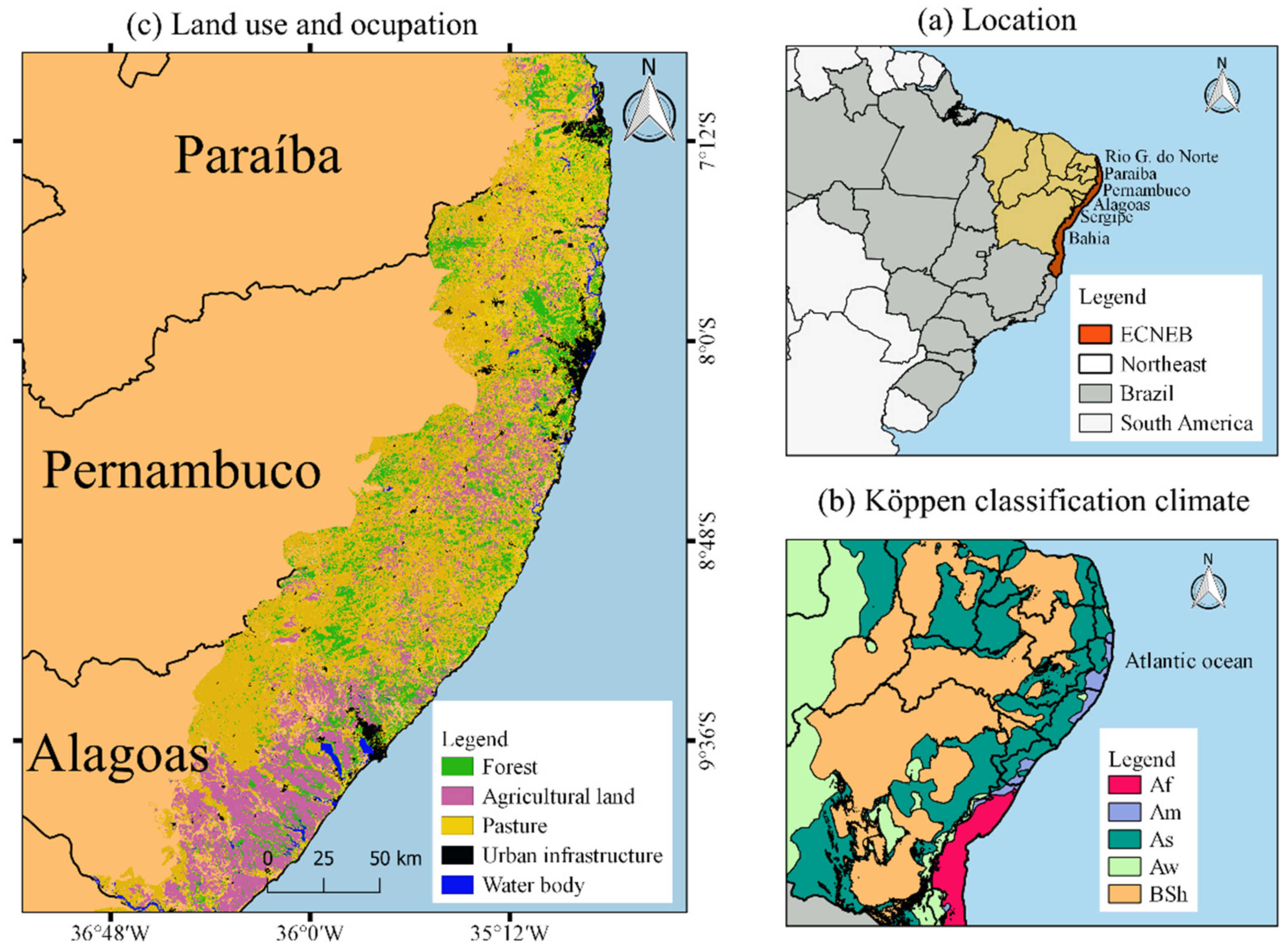

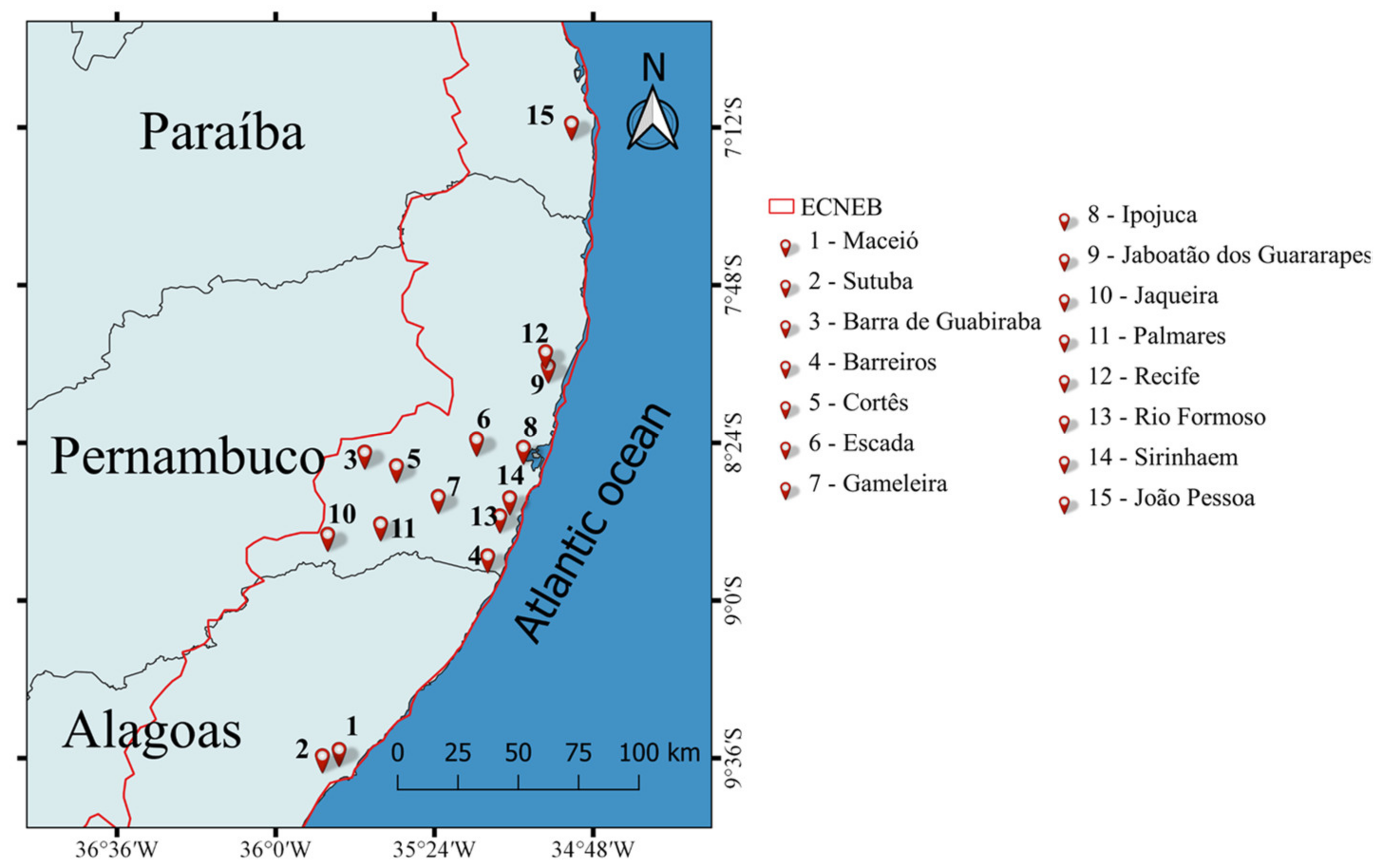
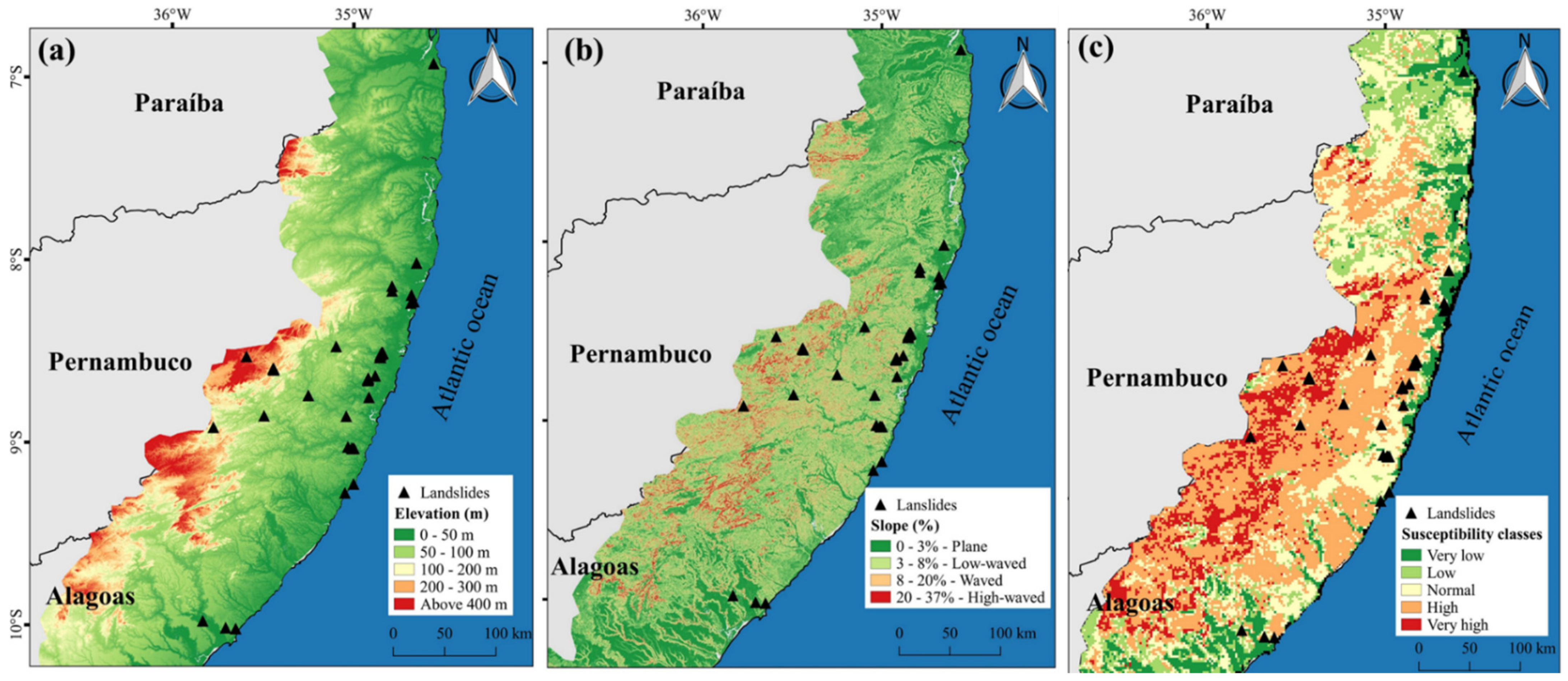



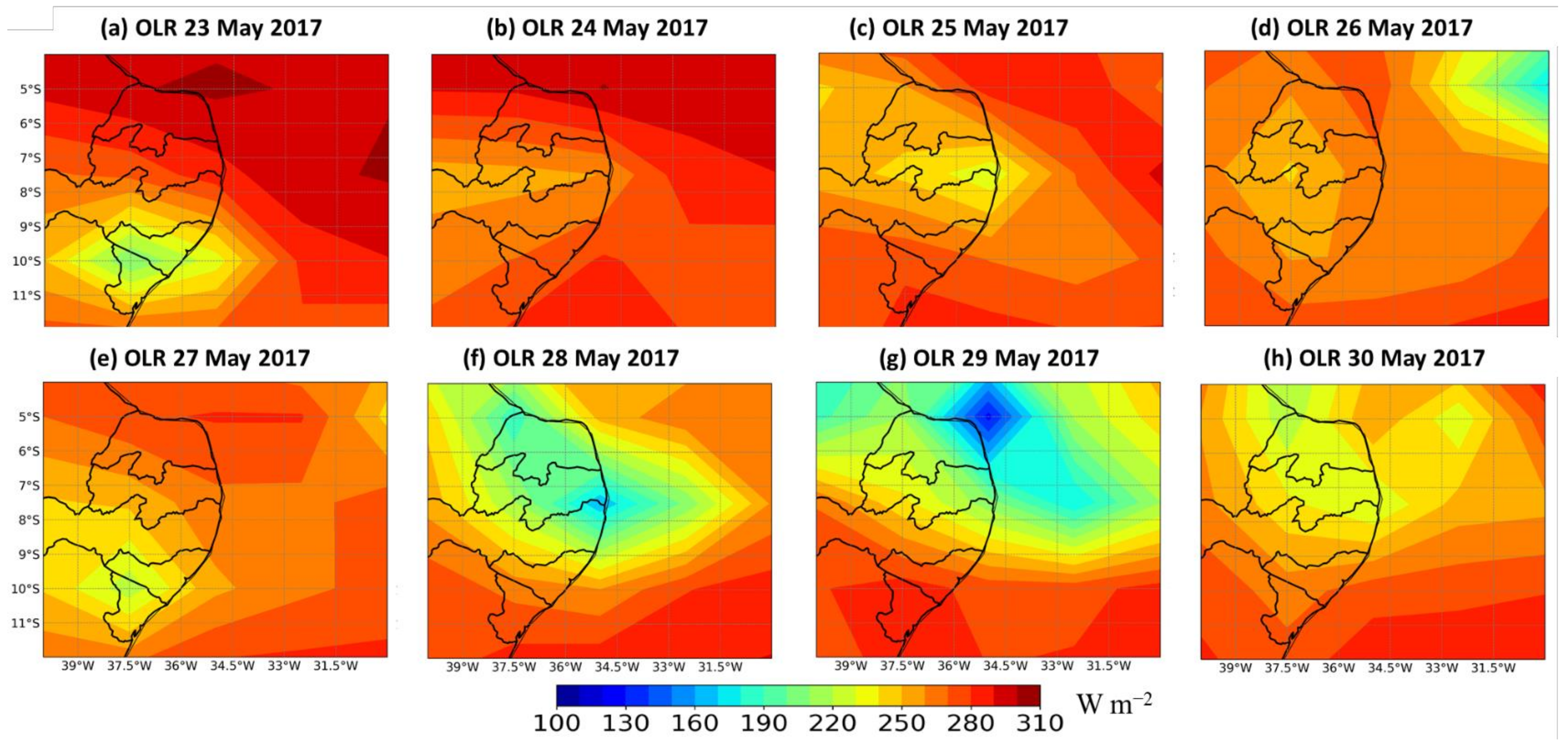


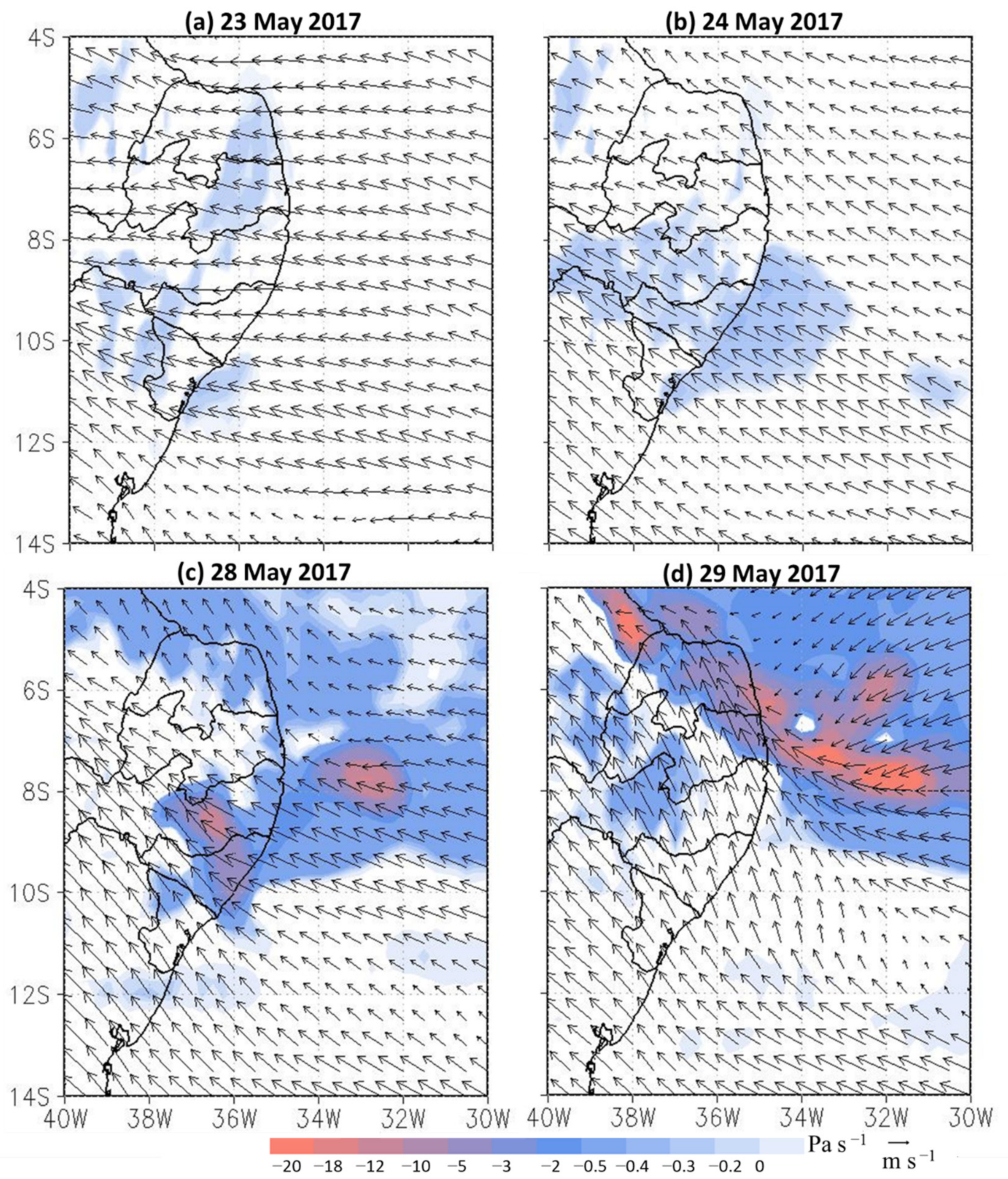
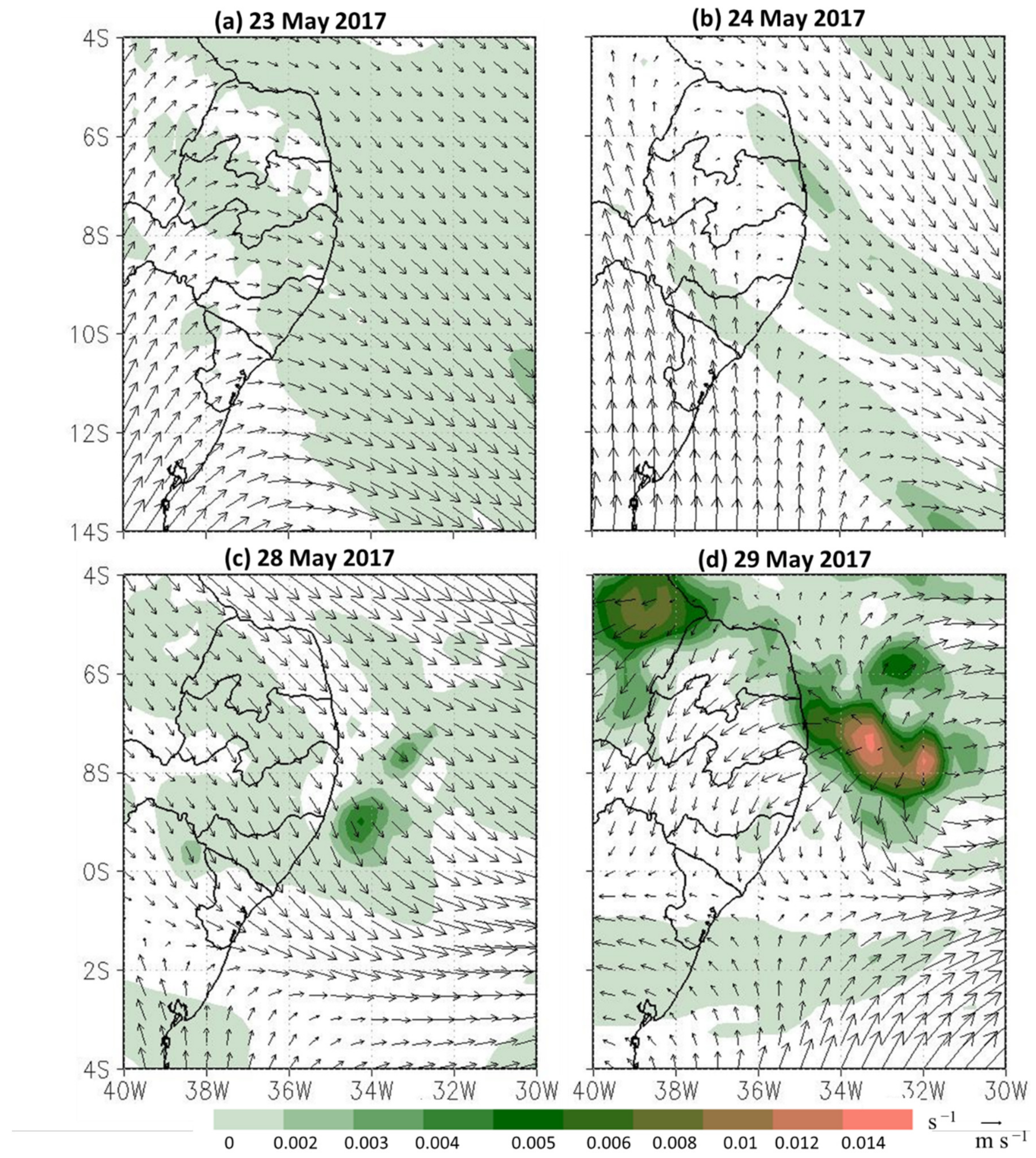
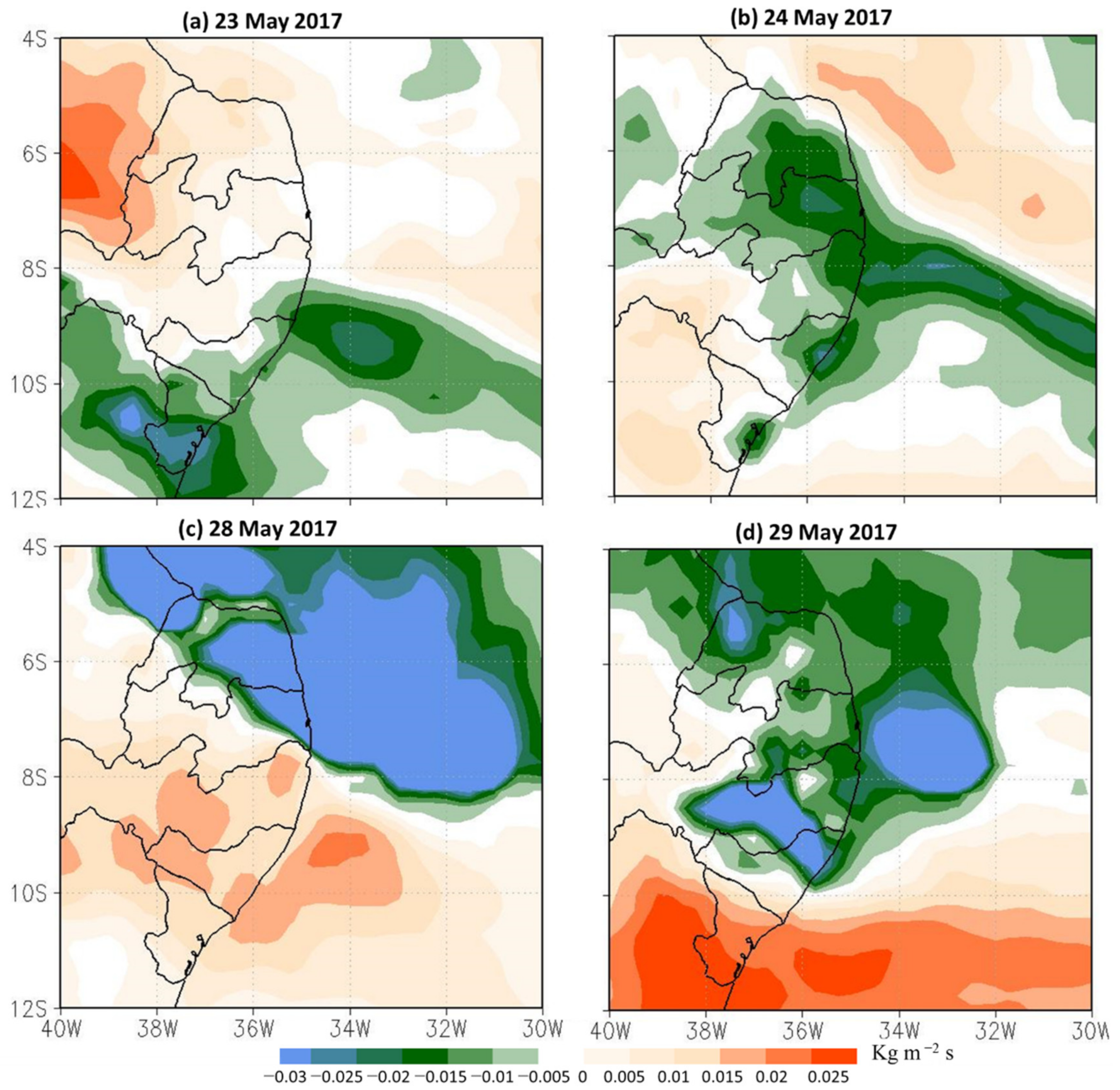
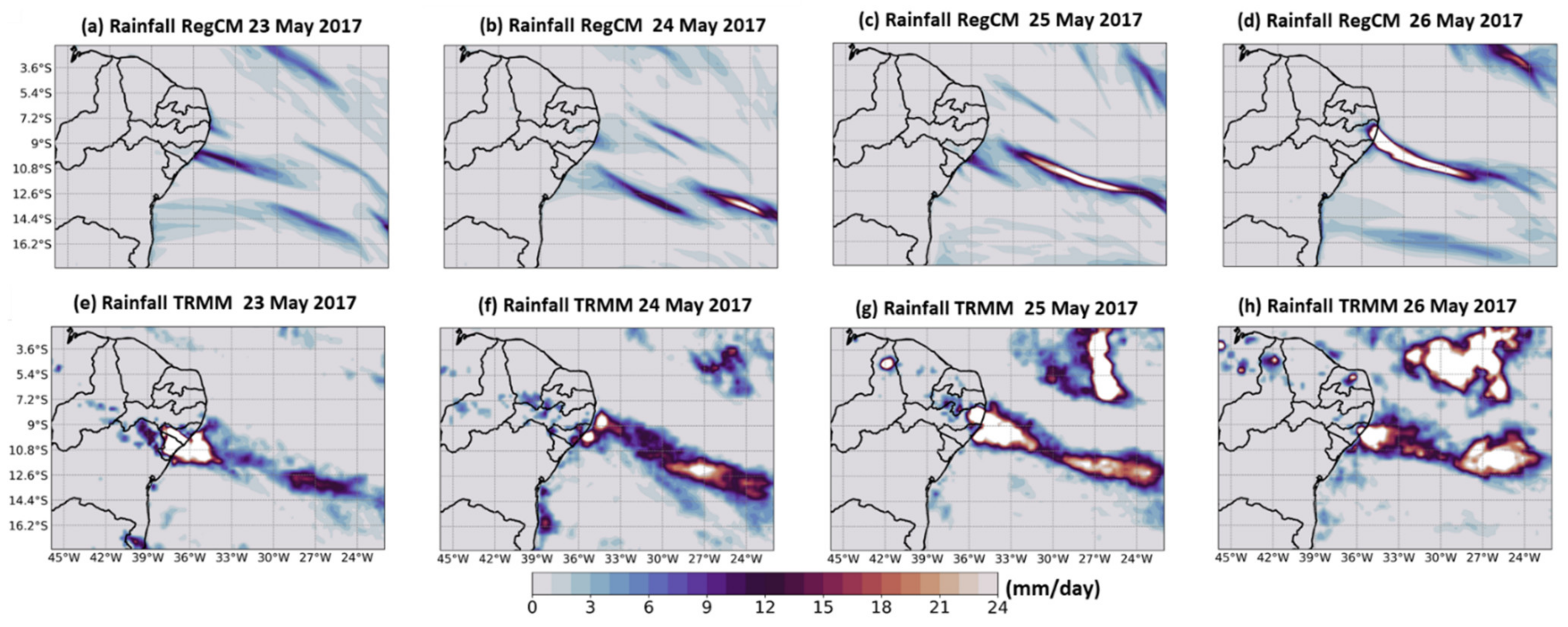
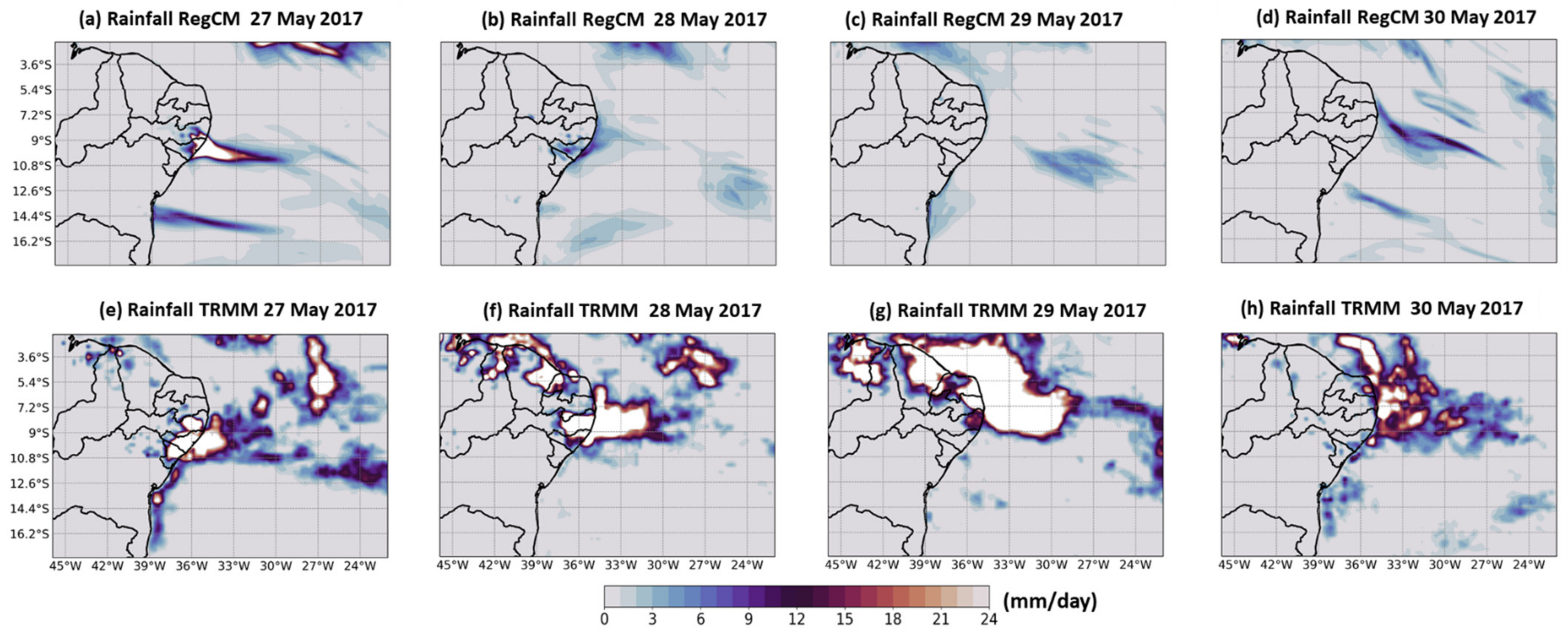

| Configuration | Parameter |
|---|---|
| Grid spacing | 12 km |
| Scheme of lateral boundary conditions | Relaxation and exponential technique, [49] |
| PBL scheme | Holtslag PBL, [50] |
| Cumulus convection scheme (mainland) | [51,52] |
| Cumulus convection scheme (ocean) | [53] |
| Moisture scheme | Explicit humidity SUBEX, [54] |
| Ocean flow scheme | [55] |
| Zeng model roughness formula | (0.0065 × ustar × ustar)/egrav |
| Radiation scheme | RRTM, [56] |
| Globdatparamssttyp Globdatparamdattyp | ERA15 ERA15 |
Publisher’s Note: MDPI stays neutral with regard to jurisdictional claims in published maps and institutional affiliations. |
© 2021 by the authors. Licensee MDPI, Basel, Switzerland. This article is an open access article distributed under the terms and conditions of the Creative Commons Attribution (CC BY) license (https://creativecommons.org/licenses/by/4.0/).
Share and Cite
Espinoza, N.S.; dos Santos, C.A.C.; Silva, M.T.; Gomes, H.B.; Ferreira, R.R.; da Silva, M.L.; Santos e Silva, C.M.; de Oliveira, C.P.; Medeiros, J.; Giovannettone, J.; et al. Landslides Triggered by the May 2017 Extreme Rainfall Event in the East Coast Northeast of Brazil. Atmosphere 2021, 12, 1261. https://doi.org/10.3390/atmos12101261
Espinoza NS, dos Santos CAC, Silva MT, Gomes HB, Ferreira RR, da Silva ML, Santos e Silva CM, de Oliveira CP, Medeiros J, Giovannettone J, et al. Landslides Triggered by the May 2017 Extreme Rainfall Event in the East Coast Northeast of Brazil. Atmosphere. 2021; 12(10):1261. https://doi.org/10.3390/atmos12101261
Chicago/Turabian StyleEspinoza, Nikolai S., Carlos A. C. dos Santos, Madson T. Silva, Helber B. Gomes, Rosaria R. Ferreira, Maria L. da Silva, Cláudio M. Santos e Silva, Cristiano P. de Oliveira, João Medeiros, Jason Giovannettone, and et al. 2021. "Landslides Triggered by the May 2017 Extreme Rainfall Event in the East Coast Northeast of Brazil" Atmosphere 12, no. 10: 1261. https://doi.org/10.3390/atmos12101261
APA StyleEspinoza, N. S., dos Santos, C. A. C., Silva, M. T., Gomes, H. B., Ferreira, R. R., da Silva, M. L., Santos e Silva, C. M., de Oliveira, C. P., Medeiros, J., Giovannettone, J., Amaro, V. E., Santos, C. A. G., & Mishra, M. (2021). Landslides Triggered by the May 2017 Extreme Rainfall Event in the East Coast Northeast of Brazil. Atmosphere, 12(10), 1261. https://doi.org/10.3390/atmos12101261












